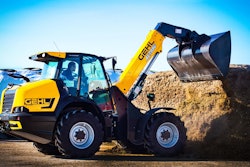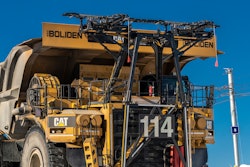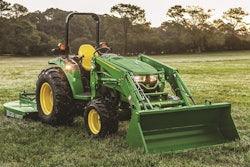
Given the widespread use of pull graders in road maintenance and finish grading, and the need to reduce costs and increase efficiency, it was only logical that, as tractors of appropriate size and power became available, a way would be devised to combine a grader’s functions into a tractor to make the grader self propelled.
The earliest known example dates to 1919, when the Russell Grader Manufacturing Company combined parts of an Allis-Chalmers wheel tractor and a Russell Hi-Way Patrol pull grader with a 6-ft. (1.8 m) long, 13-1/2 in. (34.3 cm) high blade. Unlike later motor graders, the prototype motor grader drew the blade behind the power unit; the grader drawbars were connected to the kingbolt at the same point where the tractor was connected, making for what Russell sales literature termed “absolute direct draft” to the blade.
The power unit was rated at 6-12 (meaning 6 drawbar and 12 brake) horsepower at 1,000 rpm, and was good for speeds from 1-1/2 to 3 mph (2.4-4.8 kph). Even at these low speeds, Russell literature stated that it “will do the work of three teams.” Overall length was 15 ft. 4 in. (4.6 m 10.2 cm), and it had a turning radius of 36 ft. (11 m). For comparison’s sake, a late 8T or 80C series Cat No. 12 was 25 ft. 8-3/4 in. (7.6 m 22.2 cm) long, and had a turning radius of 35 ft. 9 in. (10.7 m 22.9 cm).
Hand wheels and worm gears raised and lowered the blade in the best combination of speed and precision. The 48 x 8 in. (121.9 x 20.3 cm) smooth steel wheels on the tractor could be equipped with various lugs for use on hard-surfaced roads, gravel or sandy soil, and the grader rode on 32 x 3 in. (81.3 x 7.6 cm) wheels.
This revolutionary machine became the Motor Hi-Way Patrol when it entered production in 1920. Production was halted in 1926 at 172 units when Allis-Chalmers was forced to discontinue the tractor due to a patent dispute. The Motor Hi-Way Patrol was the forerunner of numerous variations on the tractor-combined-with-a grader theme that were built into the 1930s. As for Russell, the firm was acquired by Caterpillar in August 1928, and Cat’s highly successful line of motor graders are its direct descendants.
The Historical Construction Equipment Association (HCEA) is a 501(c)3 non-profit organization dedicated to preserving the history of the construction, dredging and surface mining equipment industries. With over 3,800 members in 25 countries, activities include publication of a quarterly educational magazine, Equipment Echoes, from which this article is adapted; operation of National Construction Equipment Museum and archives in Bowling Green, OH; and hosting an annual working exhibition of restored construction equipment. The 2020 show will be August 28-30 in Concordia, KS. Individual memberships within the USA and Canada are $35 for one year, $65.95 for two years and $99.95 for three years, and $45.00 U.S. elsewhere. HCEA seeks to develop relationships in the equipment manufacturing industry, and we offer a college scholarship for engineering and construction management students. Information is available at www.hcea.net, by calling 419-352-5616, or e-mailing [email protected]. Please reference Dept OEM.



















